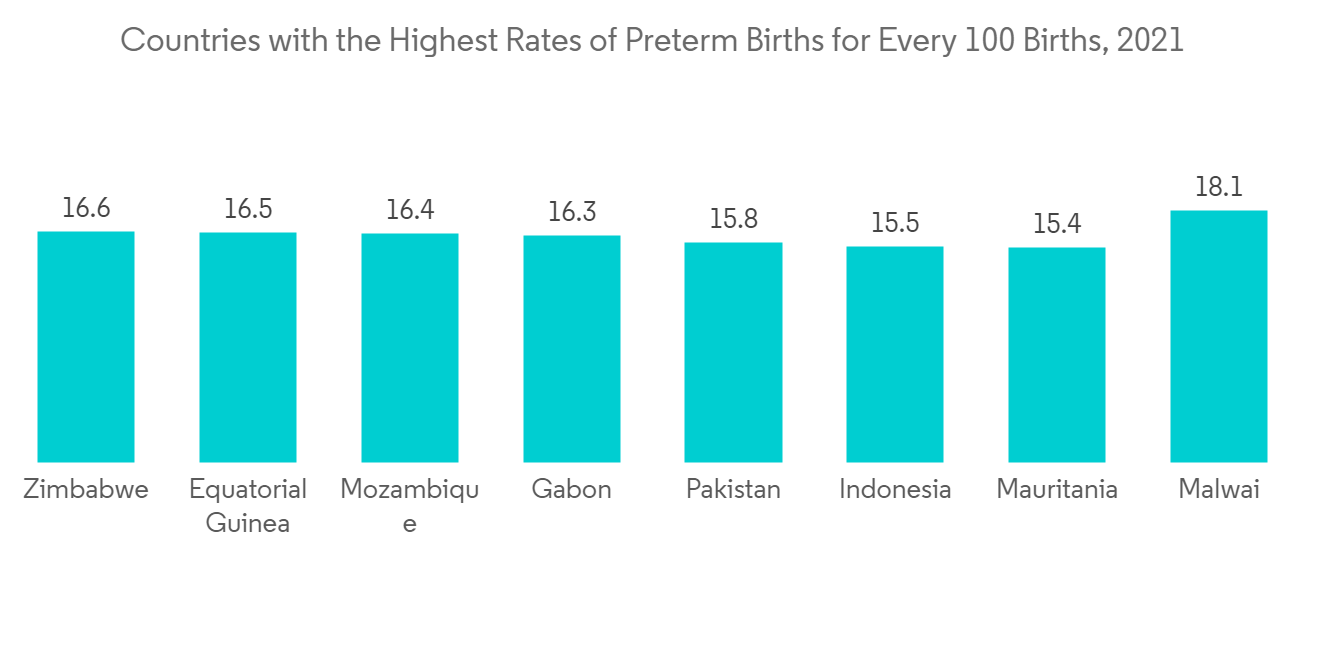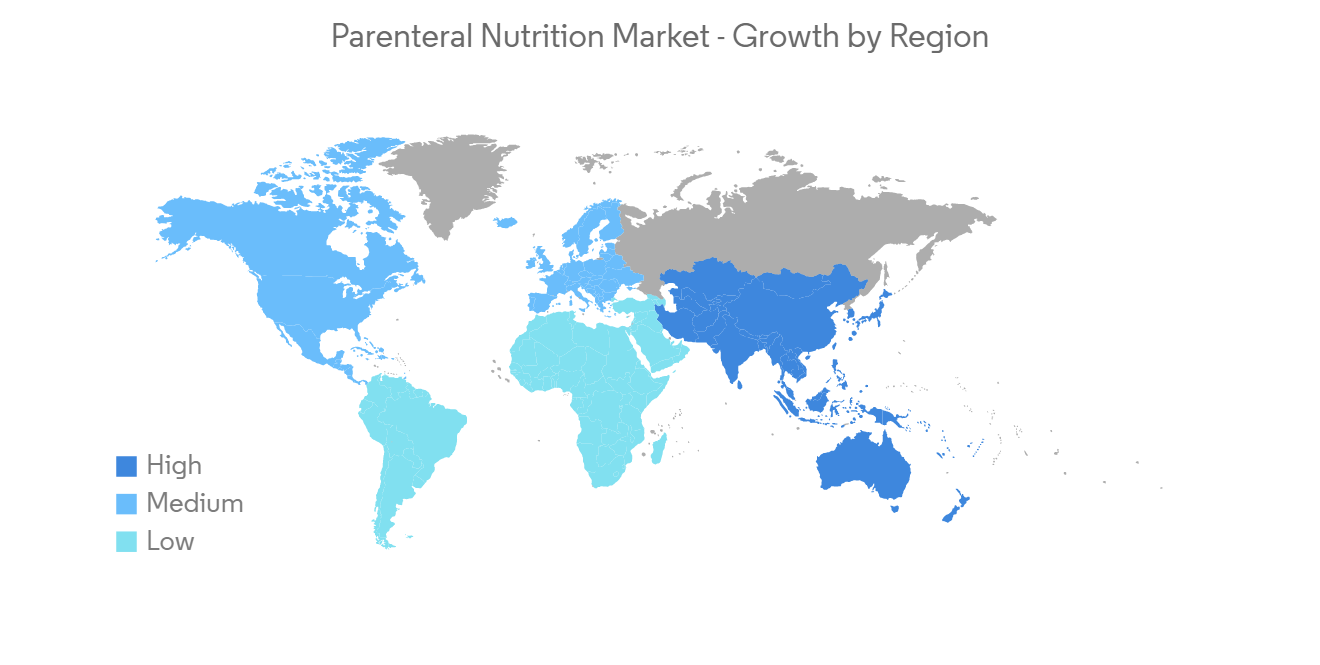PUBLISHER: Mordor Intelligence | PRODUCT CODE: 1258779

PUBLISHER: Mordor Intelligence | PRODUCT CODE: 1258779
Parenteral Nutrition Market - Growth, Trends, and Forecasts (2023 - 2028)
During the time frame of the forecast, the parenteral nutrition market is expected to grow at a CAGR of 7.7%.
The COVID-19 pandemic positively impacted the parenteral nutrition market. Parenteral nutrition plays a major role in treating COVID-19 infection-related malnutrition in patients across the globe. In 2020, the European Society for Clinical Nutrition and Metabolism established a guideline relating to the nutritional management of people infected with the SARS-CoV-2 infection. These guidelines stated that there is an urgent need for nutrition for people suffering from COVID-19 to increase their immunity, which boosted the demand for parenteral nutrition in European countries. The COVID-19 infection resulted in a severe lack of appetite, as well as other symptoms, which led to an increase in loss of muscle mass and deterioration of immune defenses. Hence, clinics and hospitals were focusing more on the provision of nutrition at the point of care. Such developments increased patient demand for and adoption of intravenous nutrition administration.Hence, the COVID-19 pandemic had a significant impact on market growth.
The main things that are driving market growth are the rise in early births, the rise in chronic diseases, and the rise in malnutrition in low- to middle-income countries.
Malnutrition includes not getting enough minerals or vitamins, being undernourished, being overweight or obese, and having a non-communicable disease that is caused by a bad diet. As per the UNICEF data published in July 2022, the prevalence of undernourishment jumped from 8.0% to 9.3% from 2019 to 2020 and rose at a slower pace in 2021 to 9.8%. Additionally, 39 million children under the age of five are overweight, 149 million have stunted growth and development as a result of a chronic lack of nutrient-rich food in their diets, and 45 million suffer from wasting.Hence, the huge burden of underweight children is likely to propel the demand for clinical nutrition and boost market growth in the coming years.
Furthermore, the high rate of premature births contributes to market growth. As per the WHO update of 2021, the rate of preterm birth ranged from 5% to 18% of babies born across 184 countries in 2021. More than 60% of preterm births occurred in Africa and South Asia in the same year and are becoming a global problem. The same source stated that in low-income countries, on average, 12% of babies are born too early, compared to 9% in high-income countries. The 10 countries with the greatest number of preterm births in 2021 include India (9,519,100), China (1,172,300), Nigeria (773,600), Pakistan (748,100), Indonesia (675,700), the United States of America (517,400), Bangladesh (424,100), the Philippines (348,900), the Democratic Republic of the Congo (341,400), and Brazil (279,300). Hence, with the high number of preterm births in various countries, the demand for parenteral nutrition is expected to rise.
But in some developing countries, people don't know much about parenteral nutrition, which slows the growth of the market.
Parenteral Nutrition Market Trends
The Hospital Segment is Expected to Hold a Major Market Share in the Parenteral Nutrition Market
Most of the parenteral nutrition is given in hospitals, which is the major factor responsible for a major share of hospitals.
Key companies operating in the market are coming up with innovative products that are benefiting hospitals. For instance, in July 2021, Micrel Medical, a medical device company specializing in infusion therapy, and Baxter Healthcare, a global leader in clinical nutrition, signed an agreement for the distribution of the Micrel Mini RythmicPN+ infusion pump for parenteral nutrition (PN) across Australia and New Zealand. Such developments are expected to boost demand for parental nutrition, driving segment growth.
Besides, as per the Medical Nutrition International Industry (MNI) data published in March 2021, up to 50% of the patients hospitalized with COVID-19 were malnourished in Belgium, which surged the demand for parenteral nutrition across the hospitals.
The prevalence of malnutrition in hospitalized patients is generally high, especially in the elderly. As per the article from PubMed published in February 2022, more than 55% of geriatric patients in hospitals were malnourished. An observational study of 6,518 seriously ill adult patients demonstrated that the survival of patients treated in surgical intensive care units is linked to malnutrition. Malnutrition is associated with an increased risk of 28-day mortality in critically ill patients.Hence, with the high prevalence of malnutrition, the segment is expected to witness healthy growth in the coming years.
Also, the fact that hospitals have better treatment options and facilities to give complete parenteral care to people with long-term illnesses is likely to make patients want to go to hospitals more often. For example, according to data from PubMed that was published in June 2022, hospitals give people with chronic intestinal obstruction total parenteral nutrition. Parenteral nutrition is one of the crucial elements of nutrition in hospitals. Thus, the segment is believed to witness strong growth in the coming years.

North America is Expected to Hold a Significant Share of the Market Over the Forecast Period
North America is expected to have a big share, and most people think that in the coming years, the United States will rule the area.
Many hospitalized patients in the United States receive parenteral nutrition. For instance, as per the Medicare data of 2021, overall, approximately 34,000 patients in the United States receive parenteral nutrition (PN) every year for critical ailments. With the high number of people receiving parenteral nutrition in the country, the market studied is expected to witness significant growth in the future.
Furthermore, as per the data provided by the American Society for Parenteral and Enteral Nutrition (ASPEN), as of January 2021, there was a 23.4% shortage of injections for certain parenteral products, including multi-vitamin infusion (adult and pediatric), amino acids, potassium acetate injection (USP), sodium acetate injection (USP), and sodium chloride. The shortage was largely attributed to the high demand for parenteral products.
According to a National Heart, Lung, and Blood Institute of the National Institute of Health article on metabolic syndrome, updated in May 2022, metabolic syndrome is very common in the United States, and around one in three American adults suffer from a type of metabolic syndrome. With the increasing occurrence of metabolic syndrome, there is a growing demand for parenteral nutrition, which is expected to boost market growth.
Due to the above-mentioned factors, it is expected that the studied market will grow significantly in North America during the forecast period.

Parenteral Nutrition Industry Overview
Parenteral nutrition is moderately competitive and consists of several major players. In terms of market share, a few of the major players are currently dominating the market and some of the companies which are currently dominating the market are Fresenius Kabi AG, B. Braun Melsungen AG, Baxter, ICU Medical, and Abbott.
Additional Benefits:
- The market estimate (ME) sheet in Excel format
- 3 months of analyst support
TABLE OF CONTENTS
1 INTRODUCTION
- 1.1 Study Assumptions and Market Definitions
- 1.2 Scope of the Study
2 RESEARCH METHODOLOGY
3 EXECUTIVE SUMMARY
4 MARKET DYNAMICS
- 4.1 Market Overview
- 4.2 Market Drivers
- 4.2.1 Growing Rate of Pre-Mature Births
- 4.2.2 Increasing Burden of Chronic Conditions
- 4.2.3 Rising Prevalence of Malnutrition
- 4.3 Market Restraints
- 4.3.1 Lack of Awareness in Developing Countries
- 4.4 Porter's Five Forces Analysis
- 4.4.1 Threat of New Entrants
- 4.4.2 Bargaining Power of Buyers/Consumers
- 4.4.3 Bargaining Power of Suppliers
- 4.4.4 Threat of Substitute Products
- 4.4.5 Intensity of Competitive Rivalry
5 MARKET SEGMENTATION
- 5.1 By Nutrition Type
- 5.1.1 Carbohydrates
- 5.1.2 Parenteral Lipid Emulsion
- 5.1.3 Single Dose Amino Acid Solution
- 5.1.4 Trace Elements
- 5.1.5 Other Nutrition Types
- 5.2 By Patient Type
- 5.2.1 Newborn
- 5.2.2 Children
- 5.2.3 Adults
- 5.3 By End-user
- 5.3.1 Hospitals
- 5.3.2 Clinics
- 5.3.3 Homecare
- 5.3.4 Other End-Users
- 5.4 Geography
- 5.4.1 North America
- 5.4.1.1 United States
- 5.4.1.2 Canada
- 5.4.1.3 Mexico
- 5.4.2 Europe
- 5.4.2.1 Germany
- 5.4.2.2 United Kingdom
- 5.4.2.3 France
- 5.4.2.4 Italy
- 5.4.2.5 Spain
- 5.4.2.6 Rest of Europe
- 5.4.3 Asia-Pacific
- 5.4.3.1 China
- 5.4.3.2 Japan
- 5.4.3.3 India
- 5.4.3.4 Australia
- 5.4.3.5 South Korea
- 5.4.3.6 Rest of Asia-Pacific
- 5.4.4 Middle East and Africa
- 5.4.4.1 GCC
- 5.4.4.2 South Africa
- 5.4.4.3 Rest of Middle East and Africa
- 5.4.5 South America
- 5.4.5.1 Brazil
- 5.4.5.2 Argentina
- 5.4.5.3 Rest of South America
- 5.4.1 North America
6 COMPETITIVE LANDSCAPE
- 6.1 Company Profiles
- 6.1.1 Fresenius Kabi AG
- 6.1.2 B. Braun Melsungen AG
- 6.1.3 Baxter International
- 6.1.4 ICU Medical
- 6.1.5 Option Care Health Inc.
- 6.1.6 Abbott
- 6.1.7 Kelun
- 6.1.8 Otsuka Pharmaceutical India Pvt. Ltd.
- 6.1.9 Amanta Healthcare
- 6.1.10 Aculife
7 MARKET OPPORTUNITIES AND FUTURE TRENDS




